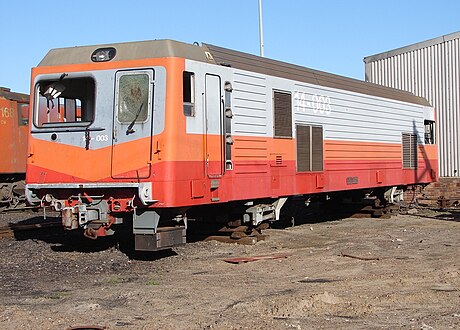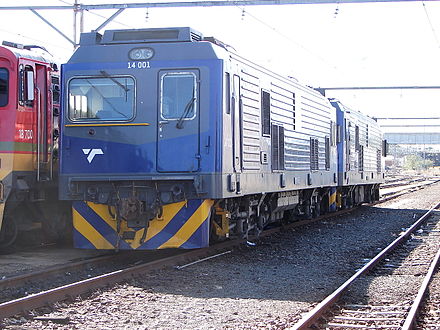Spoornet class 14E
| SAR class 14E | |
|---|---|
|
Locomotive 14 002 in the paint with the gray side member that was applied after maintenance work
|
|
| Numbering: | 14 001-14 003 |
| Number: | 3 |
| Manufacturer: | 50 Hz working group , SLM |
| Year of construction (s): | 1990 |
| Retirement: | 2014– |
| Axis formula : | Bo'Bo ' |
| Gauge : | 1067 mm ( cape track ) |
| Length over coupling: | 18,500 mm |
| Height: | 4,120 mm |
| Width: | 4,047 mm |
| Trunnion Distance: | 9,300 mm |
| Bogie axle base: | 3,100 mm |
| Total wheelbase: | 12,400 mm |
| Smallest bef. Radius: | 85 m |
| Service mass: | 92.5 t |
| Wheel set mass : | 23.125 t |
| Top speed: | 140 km / h |
| Continuous output : | 4,080 kW |
| Starting tractive effort: | 300 kN |
| Hourly traction: | 198 kN |
| Continuous tensile force: | 194 kN |
| Driving wheel diameter: | 1250 mm |
| Power system : | 25 kV 50 Hz alternating current 3 kV direct current |
| Number of traction motors: | 4th |
| Drive: | Hollow shaft drive |
| Brake: | Compressed air brake , regenerative brake below 3 kV, resistance brake below 25 kV 50 Hz |
| Train brake: | Air brake |
| Train heating: | 400 kW |
| Coupling type: | AAR coupling |
The Spoornet class 14E is a 1991 procured four-axis dual-system - electric locomotive of the South African Spoornet , the kV 3 dc or 25 kV 50 Hz AC can operate. The class 14E locomotives were the first multi-system vehicles in South Africa.
history
In January 1984 the South African Railways (SAR) put out a tender for the delivery of six prototype locomotives for dual-system operation. It was required that the bogies are equipped with radially adjustable axles and fully sprung traction motors . The traction power should be 3.8 MW, in addition, the locomotive had to be able to provide 400 kW for the train busbar. The maximum axle load was set at 22 t and the top speed at 160 km / h.
The order went to the 50 Hz consortium , which consisted of the manufacturers Ateliers de Constructions Electriques de Charleroi (ACEC) from Belgium , AEG and Siemens from Germany , Alstom from France and Brown Boveri (BBC) from Switzerland . The final assembly of the locomotives took place at the Schweizerische Lokomotiv- und Maschinenfabrik (SLM) in Winterthur , which supplied the mechanical part of the locomotives. Only three instead of six prototype locomotives were built, which were delivered in 1990.
technology
The locomotives have two driver's cabs. Next to the left access door to driver's cab 1, step pockets for roof access are embedded in the locomotive body. The devices in the engine room are arranged along a central aisle that connects the two driver's cabs.
In contrast to the 19E , 20E and 21E series locomotives that were delivered later, the 14E series cannot change the system while the vehicle is in motion. The locomotive had to be stopped to be upgraded under the other voltage.
When it went into operation in 1990, the 14E series was one of Spoornet's most powerful locomotives. It was driven by three-phase asynchronous motors from Siemens, which also supplied the control technology and the current-controlled converters .
The 14E were the first locomotives in South Africa with herringbone gears and solid wheels . All other South African locomotives with the exception of the class 9E locomotives used on the ore railway to Saldanha were designed with spoked wheels and straight-toothed gears. The Spoornet class 14E1 locomotives built later in South Africa again received spoked wheels, but with helical gears.
Factory numbers
In the following the serial numbers of the transformers, which are arranged underfloor between the two bogies, are given. They have a different order than the vehicle numbers. SLM has assigned factory numbers for the mechanical equipment. The numbers, the delivery date to Spoornet for test operation and the handover date to regular operation are listed in the table below.
| Locomotive no. | SLM no. | Transformer no. | delivery | Start of regular operation |
|---|---|---|---|---|
| 14 001 | 5415 | HST 16657-1-3 / 1988 | June 26, 1990 | November 26, 1991 |
| 14 002 | 5416 | HST 16657-1-1 / 1988 | September 9, 1990 | November 26, 1991 |
| 14 003 | 5417 | HST 16657-1-2 / 1988 | September 21, 1990 | November 26, 1991 |
commitment
The class 14E locomotives are located in the Bellville depot near Cape Town and are mostly only used for freight trains below 3 kV on the Cape Town – Beaufort West route. With the exception of the ore railway to Saldanha, which is electrified with 50 kV 50 Hz, the two-system locomotives can be used on all overhead lines in South Africa. Sometimes the locomotives were used in front of the Blue Train over the entire route Cape Town - Pretoria , where they drove the Beaufort West - Kimberley stretch, spanned with 25 kV 50 Hz . Normally this task was taken over by special class 14E1 locomotives with a blue paint to match the wagons. Both series were withdrawn from this service and replaced by the Spoornet class 18E after the 14 104 locomotive in 2013 and the 14 001 locomotive in 2014 were destroyed by electrical fires while in use in front of the Blue Train.
As part of a sale-lease-back contract , Spoornet sold some of the electric locomotives and most of the Spoornet class 38 diesel locomotives to Maquarie-GETX ( General Electric Financing) in 1998 , which leased them to Spoornet for a period of ten years. The leasing contract, which expired in 2008, included the 14E locomotives 14 002 and 14 003.
photos
All locomotives of the 14E series were painted in orange, gray and red, which is unique for South African locomotives. The Spoornet logo and the Spoornet lettering on the long side of the car body was only applied to the 14 002 as part of repair and maintenance work. At the same time, the red paint on the long side was replaced by orange and the side member was painted gray. 14 001 was given the blue Blue Train paint in 2012.
14 001 in front of the Belleville depot near Cape Town on June 6, 2010
Bogie of the locomotive 14 003
Locomotive 14 001 in the Blue Train livery near Beaufort West in May 2013
Web links
Individual evidence
- ↑ a b c d South African Railways Index and Diagrams Electric and Diesel Locomotives, 610mm and 1065mm Gauges. 1975.
- ^ Leith Paxton, David E. Bourne: Locomotives of the South African Railways: A Concise Guide . C. Struik, 1985, ISBN 0-86977-211-2 ( limited preview in Google Book Search).
- ↑ TFR (Ed.): SAR class 14E1 - main dimensions and technical data .
- ^ Ewald Falke: TRAXX Africa - Class 23E locomotives for heavy goods traffic in South Africa. In: Electric Railways. December 2015, accessed April 22, 2016 .
- ^ A b c John N. Middleton: Railways of Southern Africa: Locomotive Guide 2002 . Beyer-Garralt Publications, January 1, 1994 ( limited preview in Google Book Search).






